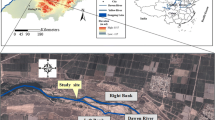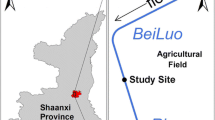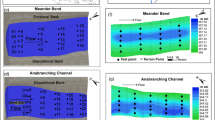Abstract
Streambed vertical hydraulic conductivity (K v) is a key parameter in the analysis of interactions between streams and aquifers, and of stream ecosystems. However, knowledge of the streambed hydraulic conductivity associated with different stream morphologies is relatively scarce. An in-situ standpipe permeameter test method was used to determine the spatial variability in streambed K v measured along 18.5 km of stream reach in the Beiluo River, Shaanxi Province, China. The 59 total measurements were conducted at four test sites in three different stream morphologies: straight channel, anabranching channels and a nearby meander bend. There was great spatial variability in K v among the four test sites and three K v distribution patterns can be determined: (1) higher K v values appear on the erosional bank in contrast to lower K v values on the depositional bank at the two sites near meander bends; (2) the K v distribution in straight channels shows that the higher K v values occur in the center of the channel; (3) the K v values are generally highest on the branch with more alluvial forms in the anabranching channels. Moreover, grain-size analysis results illustrate that the average grain-size distributions of streambed sediments are significantly different on each side of the channel. The erosional and depositional forms are one of the driving dynamics for the distribution of streambed grain size that trigger the differences in the distribution of the K v.
Résumé
La conductivité hydraulique verticale du lit d’un cours d’eau (K v) est un paramètre clé dans l’analyse des interactions entre cours d’eau et aquifères, et des écosystèmes fluviaux associés. Cependant, la connaissance de la conductivité hydraulique du lit d’un cours d’eau, associée à différentes morphologies d’écoulements, est assez rare. Une méthode d’essai in-situ au perméamètre a été utilisée pour déterminer la variabilité spatiale de K v dans le lit d’un cours d’eau, mesurée sur un tronçon d’une longueur de 18.5 km de la rivière Beiluo, dans la province de Shaanxi, en Chine. Les 59 mesures au total ont été réalisées sur quatre sites tests situés au niveau de trois morphologies d’écoulement différentes: une zone d’écoulement rectiligne, un réseau anastomosé et une zone de méandre à proximité d’un coude. Il y a eu une grande variabilité spatiale de la valeur K v au droit des quatre sites tests et trois modèles de distribution de K v peuvent être déterminés: (1) les valeurs les plus élevées de K v apparaissent sur la rive soumise à l’érosion, à l’opposé des valeurs de K v plus faibles qui sont rencontrées sur la rive soumise aux dépôts (pour les deux sites proches des méandres); (2) la distribution du paramètre K v au droit des zones d’écoulement rectiligne montre que les valeurs de K v les plus élevées sont constatées au centre du cours d’eau; (3) les valeurs de K v sont généralement les plus élevées sur la partie avec le plus de formes alluviales du réseau anastomosé. De plus, les résultats de l’analyse granulométrique indiquent que les distributions moyennes de la taille des grains des sédiments du lit du cours d’eau sont significativement différentes de part et d’autre du cours d’eau. Les formes d’érosion et de dépôt sont l’une des dynamiques qui déterminent la distribution de la taille des grains du lit du cours d’eau et qui sont à l’origine des différences dans la distribution de K v.
Resumen
La conductividad hidráulica vertical de un cauce (K v) es un parámetro clave en el análisis de las interacciones entre los ríos y acuíferos, y de los ecosistemas fluviales. Sin embargo, el conocimiento de la conductividad hidráulica del cauce asociado con diferentes morfologías de la corriente es relativamente escaso. Se utilizó como método de ensayo el permeámetro del tubo vertical para determinar la variabilidad espacial en el cauce K v medida a lo largo de un tramo de 18.5 kilometros de río en el río Beiluo, provincia de Shaanxi, China. Se llevaron a cabo un total de 59 mediciones en cuatro sitios de prueba en tres morfologías diferentes: en el canal recto, en canales ramificados y en la curva de un meandro cercano. Se reconoció una gran variabilidad espacial en K v entre los cuatro sitios de prueba y tres patrones de distribución de K v se pueden determinar: (1) Los valores de K v más altos aparecen en la orilla de erosión en contraste con valores más bajos K v en la orilla de sedimentación en los dos sitios cercanos de las curvas meandro; (2) la distribución K v en canales rectos muestra que los valores de K v más altos se producen en el centro de la canal; (3) los valores K v son generalmente más altos en la ramificación con más formas aluviales en los canales ramificados. Por otra parte, los resultados del análisis de tamaño de grano ilustran que las distribuciones de tamaño promedio de grano de los sedimentos de los cauces son significativamente diferentes en cada lado del canal. Las formas de erosión y de sedimentación constituyen los comportamientos dinámicos para la distribución de tamaño de grano en el cauce, los cuales desencadenan las diferencias en la distribución de la K v.
摘要
河床垂向渗透系数是分析河流-含水层相互作用及其河流生态系统的重要参数之一。目前对河床渗透系数与河貌类型的影响效应研究相对较少。本文采用水头下降竖管渗透试验法在北洛河4个研究点、3种不同河貌类型(弯曲河道、直河道、分叉型河道)的共59个试验点位做了垂向渗透系数测试与分析研究。结果表明:在弯曲河道,垂向渗透系数在侵蚀岸值较大,而沉积岸的值较小;在直河道,河道中间比两岸的垂向渗透系数值都大;在分叉型河道,冲蚀能力较大,垂向渗透系数较大。同时,河床平均粒径的大小在河道两岸及中间都有明显差异,河流侵蚀与沉积的过程是引起河床沉积物粒径大小分异的重要因素,从而对垂向渗透系数大小的差异起到了显著的影响作用。
Resumo
A condutividade hidráulica vertical de leito de rio (K v) é um parâmetro chave na análise de interações entre cursos d’água, aquíferos e ecossistemas de fluxo. Entretanto, a compreensão da condutividade hidráulica de leitos de rios associada à distintas morfologias de fluxo é relativamente escarça. O método de teste através de um permeâmetro vertical in-situ foi usado para determinar a variabilidade espacial de K v de leito de rio, medido ao longo de 18.5 km do fluxo no Rio Beiluo, Província de Shaanxi, China. Um total de 59 medidas foram conduzidas em quatro locais de teste em três morfologias de fluxo diferentes: canal linear, canais com ramificações e uma abertura em meandro. Houve uma grande variabilidade espacial na K v entre os quatro locais de teste e três padrões de distribuição de K v puderam ser determinados: (1) valores maiores de K v aparecem no banco erosional, em contraste com valores menores de K v nos bancos deposicionais nos dois locais próximos às aberturas em meandros; (2) a distribuição de K v em canais lineares mostra que valores de K v mais altos ocorrem no centro do canal; (3) os valores de K v são geralmente os mais altos no ramo com mais formações aluviais, nos canais com ramificação. Além disso, a análise de tamanho de grãos ilustra que as distribuições de tamanho médio de tamanho de grãos dos sedimentos do rio são significativamente diferentes em cada lado do canal. As formações erosionais e deposicionais são uma das dinâmicas forçantes para a distribuição de tamanho de grãos do leito do rio, que ocasiona as diferenças na distribuição de K v.





Similar content being viewed by others
References
Bardini L, Boano F, Cardenas MB, Sawyer AH, Revelli R (2013) Ridolfi L (2013) Small-scale permeability heterogeneity has negligible effects on nutrient cycling in streambeds. Geophys Res Lett 40(6):1118–1122. doi:10.1002/grl.50224
Boano F, Camporeale C, Revelli R, Ridolfi L (2006) Sinuosity-driven hyporheic exchange in meandering rivers. Geophys Res Lett 33(18). doi:10.1029/2006GL027630
Cardenas MB, Wilson JL, Zlotnik VA (2004) Impact of heterogeneity, bed forms, and stream curvature on subchannel hyporheic exchange,.Water Resour Res. 40. doi:10.1029/2004WR003008
Chen XH (2004) Streambed hydraulic conductivity for rivers in south-central Nebraska. J Am Water Resour As 40(3):561–573. doi:10.1111/j.1752-1688.2004.tb04443.x
Chen XH (2005) Statistical and geostatistical features of streambed hydraulic conductivities in the Platte River, Nebraska. Environ Geol 48(6):693–701. doi:10.1007/s00254-005-0007-1
Chen XH, Burbach M, Cheng C (2008) Electrical and hydraulic vertical variability in channel sediments and its effects on streamflow depletion due to groundwater extraction. J Hydrol 352(3-4):250–266. doi:10.1016/j.jhydrol.2008.01.004
Dong QG, Zhou WB, Liu L, Shu YY, Li YP (2014) Analysis of runoff variation characteristics of Beiluohe River (in Chinese). Yellow River 36(2):20–29
Dong WH, Chen XH, Wang ZW, Ou GX, Liu C (2012) Comparison of vertical hydraulic conductivity in a streambed-point bar system of a gaining stream. J Hydrol 450:9–16. doi:10.1016/j.jhydrol.2012.05.037
Edwardson KJ, Bowden WB, Dahm C, Morrice J (2003) The hydraulic characteristics and geochemistry of hyporheic and parafluvial zones in Arctic tundra streams, north slope, Alaska. Adv Water Resour 26(9):907–923. doi:10.1016/S0309-1708(03)00078-2
Genereux DP, Leahy S, Mitasova H, Kennedy CD, Corbett DR (2008) Spatial and temporal variability of streambed hydraulic conductivity in West Bear Creek, North Carolina, USA. J Hydrol 358(3–4):332–353. doi:10.1016/j.jhydrol.2008.06.017
Huang HQ, Nanson GC (2007) Why some alluvial rivers develop an anabranching pattern. Water Resour Res 43(7):2007. doi:10.1029/2006WR005223
Hvorslev MJ (1951) Time lag and soil permeability in ground-water observations. Waterways Experiment Station, US Army Bull 36, US Army Corps of Engineers, Vicksburg, MI, 50 pp
Irvine DJ, Brunner P, Franssen HJ, Simmons CT (2012) Heterogeneous or homogeneous? Implications of simplifying heterogeneous streambeds in models of losing streams. J Hydrol 424:16–23. doi:10.1016/j.jhydrol.2011.11.051
Kalbus E, Reinstorf F, Schirmer M (2006) Measuring methods for groundwater–surface water interactions: a review. Hydrol Earth Syst Sci 10(6):873–887. doi:10.5194/hess-10-873-2006
Käser DH, Binley A, Heathwaite AL, Krause S (2009) Spatio-temporal variations of hyporheic flow in a riffle-step-pool sequence. Hydrol Process 23(15):2138–2149. doi:10.1002/hyp.7317
Koch JC, McKnight DM, Neupauer RM (2011) Simulating unsteady flow, anabranching, and hyporheic dynamics in a glacial meltwater stream using a coupled surface water routing and groundwater flow model. Water Resour Res 47(5):2011. doi:10.1029/2010WR009508
Landon MK, Rus DL, Harvey FE (2001) Comparison of instream methods for measuring hydraulic conductivity in sandy streambeds. Groundwater 39(6):870–885. doi:10.1111/j.1745-6584.2001.tb02475.x
Larkin RG, Sharp JM (1992) On the relationship between river-basin geomorphology, aquifer hydraulics, and ground-water flow direction in alluvial aquifers. Geol Soc Am Bull 104(12):1608–1620
Lawlor SM (2004) Determination of channel-morphology characteristics, bankfull discharge, and various design-peak discharges in western Montana. US Geol Surv Sci Invest Rep 2004-5263
Leek R, Wu JQ, Wang L, Hanrahan TP, Barber ME, Qiu HX (2009) Heterogeneous characteristics of streambed saturated hydraulic conductivity of the Touchet River, south eastern Washington, USA. Hydrol Process 23(8):1236–1246. doi:10.1002/hyp.7258
Levy J, Birck MD, Mutiti S, Kilroy KC, Windeler B, Idris O, Allen LN (2011) The impact of storm events on a riverbed system and its hydraulic conductivity at a site of induced infiltration. J Environ Manag 92:1960–1971. doi:10.1016/j.jenvman.2011.03.017
Malard F, Tockner K, Dole-olivier MJ, Ward JV (2002) A landscape perspective of surface–subsurface hydrological exchanges in river corridors. Freshw Biol 47(4):621–640
Min LL, Yu JJ, Liu CM, Zhu JT, Wang P (2013) The spatial variability of streambed vertical hydraulic conductivity in an intermittent river, northwestern China. Environ Earth Sci 69:873–883. doi:10.1007/s12665-012-1973-8
Nowinski JD, Cardenas MB, Lightbody AF (2011) Evolution of hydraulic conductivity in the floodplain of a meandering river due to hyporheic transport of fine materials. Geophys Res Lett 38:2011. doi:10.1029/2010GL045819
Roque AJ, Didier G (2006) Calculating hydraulic conductivity of fine-grained soils to leachates using linear expressions. Eng Geol 85(1):147–157
Sebok E, Duque C, Engesgaard P, Bøgh E (2013) Anisotropy of streambed sediments of contrasting geomorphological environments and its relation to groundwater discharge. EGU General Assembly Conference Abstracts, EGU2013-4529, EGU General Assembly, Vienna, April 2013
Sebok E, Duque C, Engesgaard P, Boegh E (2014) Spatial variability in streambed hydraulic conductivity of contrasting stream morphologies: channel bend and straight channel. Hydrol Process. doi:10.1002/hyp.10170
Shepherd RG (1989) Correlations of permeability and grain size. Groundwater 27(5):633–638. doi:10.1111/j.1745-6584.1989.tb00476.x
Shi HL, Zhang L, Yue LP, Zheng GZ (2008) Petroleum hydrocarbon contamination in surface sediments of Beiluohe Basins, China. Bull Environ Contam Toxicol 81(4):416–421. doi:10.1007/s00128-008-9419-4
Song JX, Chen XH, Cheng C, Wang DM, Lackey S, Xu ZX (2009) Feasibility of grain-size analysis methods for determination of vertical hydraulic conductivity of streambeds. J Hydrol 375(3–4):428–437. doi:10.1016/j.jhydrol.2009.06.043
Song JX, Chen XH, Cheng C, Wang DM, Wang WK (2010) Variability of streambed vertical hydraulic conductivity with depth along the Elkhorn River, Nebraska, USA. Chin Sci Bull 55(10):992–999. doi:10.1007/s11434-009-0640-2
Zhang L, Shi KL, Yue LP (2007) Chemical characteristics and pollution sources of petroleum hydrocarbons and PAHs in sediments from the Beiluohe River, northern China. Environ Geol 53(2):307–315. doi:10.1007/s00254-007-0645-6
Acknowledgements
This study was jointly supported by the National Natural Science Foundation of China (Grant Nos. 51079123, 51379715 and 51309107), Program for Key Science and Technology Innovation Team in Shaanxi Province (Grant No. 2014KCT-27), Program for New Century Excellent Talents in University (Grant No.NCET-11-1045), the open funds from State Key Laboratory of Hydraulics and Mountain River Engineering, Sichuan University (SKLH-OF-1212) and Program for Graduated Student Innovation Talents Training in Northwest University (Grant No. YZZ14011). We would like to thank the editor, the associate editor, and the anonymous reviewers for their constructive comments.
Author information
Authors and Affiliations
Corresponding author
Rights and permissions
About this article
Cite this article
Jiang, W., Song, J., Zhang, J. et al. Spatial variability of streambed vertical hydraulic conductivity and its relation to distinctive stream morphologies in the Beiluo River, Shaanxi Province, China. Hydrogeol J 23, 1617–1626 (2015). https://doi.org/10.1007/s10040-015-1288-4
Received:
Accepted:
Published:
Issue Date:
DOI: https://doi.org/10.1007/s10040-015-1288-4




